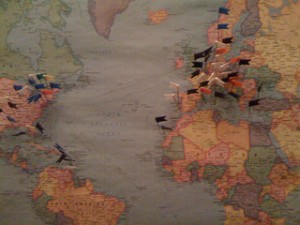Every year, when Fortune publishes its list of the 100 Best Companies to Work For (2010 should be along soon, by the way), a healthy percentage of the reader comments are some version of “that may be true about Company X in general, but where I work . . . “
For the most part, people employed by large corporations identify with the local office or agency where they work, the division or department they work in, the group that they work with. And that has several implications for the corporate Careers site.
1. Very large companies may have many separate divisions or subsidiaries, multiple global entities, and/or numerous entry paths (new graduate, experienced professional, hourly worker, and so on).
Q: How can the site effectively communicate across all these possibilities?
2. Mid-sized to large companies may have dozens of locations and/or many different departments and groups.
Q. What if there are differences in culture and policies among these various entities?
3. Employee profiles and testimonials from selected segments of the organization may not reflect other segments accurately at all.
Q: Are there issues of misrepresentation (intentionally or otherwise)?
4. Combining a variety of entities into one site may be confusing for visitors—but splitting them up into a lot of semi-related sites may be confusing in a different way.
Q: What’s the best approach for a specific company?
5. Different entities within the organization may have different (even radically different) visions of the Careers site–objectives, approach, style, functionality, et cetera.
Q: How can competing needs be reconciled?
6. Unfortunate events, management problems, and other negative circumstances may afflict just one component of the company but spread bad publicity to other components.
Q: Can the employer brand be protected from the effects of localized difficulties?
Those are just some of the issues—and there are no easy answers. However, each question is worth serious strategic consideration
Two observations:
- Microsites can be used to present smaller employment segments more effectively and accurately.
- It takes attentive oversight to successfully communicate one employer brand across many employment segments.
Two good examples:
Far-flung KPMG does a nice job of integrating multiple locations and career pthats.
Global Website: http://www.kpmg.com/Global/JoinUs/
U.S. Website: http://www.kpmgcareers.com/index.shtml
Multi-functional Sodexo makes great use of microsites for diversified messaging and social media for unified messaging.
http://www.sodexousa.com/usen/careers/careers.asp
One more point worth noting:
Six of the top ten qualities that contribute to job satisfaction (according to SHRM’s 2009 Employee Job Satisfaction Survey) are more concerned with the local workplace than with the company at large:
- opportunities to use skills and abilities
- feeling safe in the work environment
- relationship with immediate supervisor
- management recognition of employee job performance
- communication between employees and senior management
- the work itself
- autonomy and independence
(Merci to nicholasnova for the great graphic.)
Cynthia Giles has followed a serpentine career path from academia to publishing to marketing and design to information technology and corporate communications. There’s plenty of detail about this journey at www.cynthiagiles.com, but briefly--the common theme has been ideas, and how to present them effectively. Along the way, she became an accidental expert on data warehousing and business intelligence, and for the past ten years she has combined corporate contracting with an independent consulting practice that focuses on marketing strategy for smaller businesses and non-profits.
Having spent quite a bit of time looking for work, and anywhere from two weeks to two years inside a wide variety of American companies—she has given much thought to what works (and what doesn’t) when it comes to creating a great employment fit.


